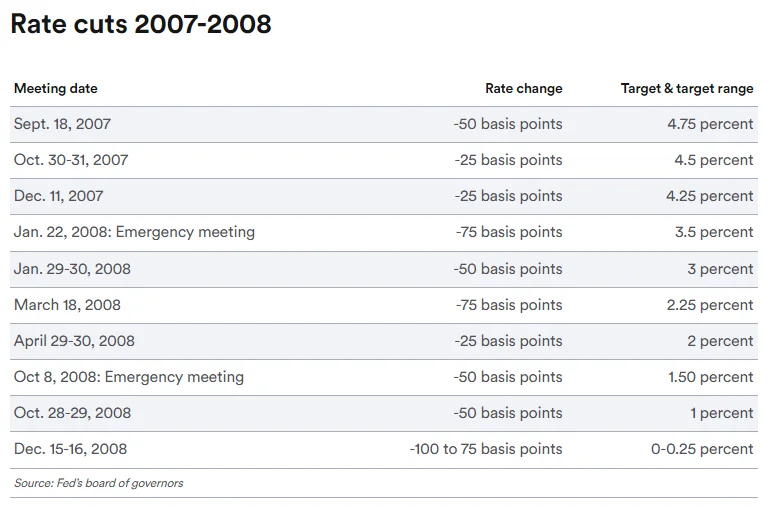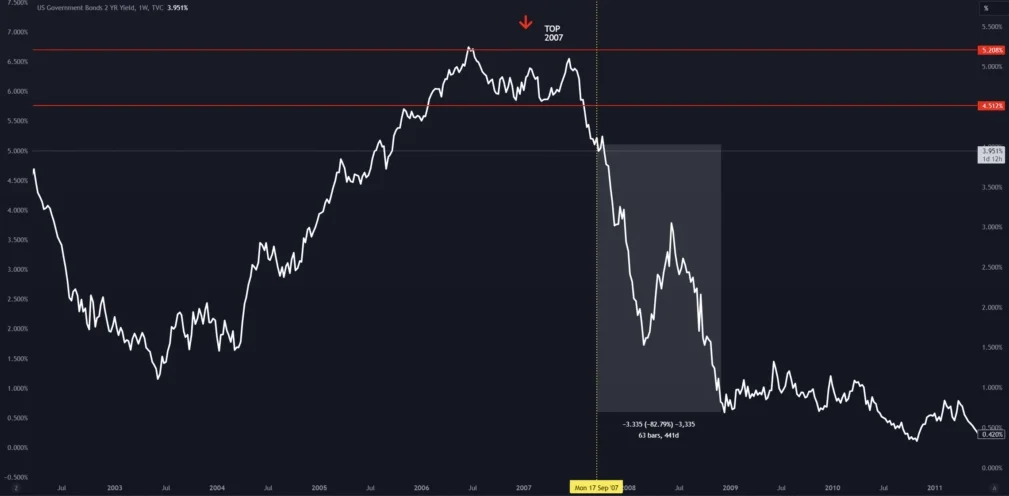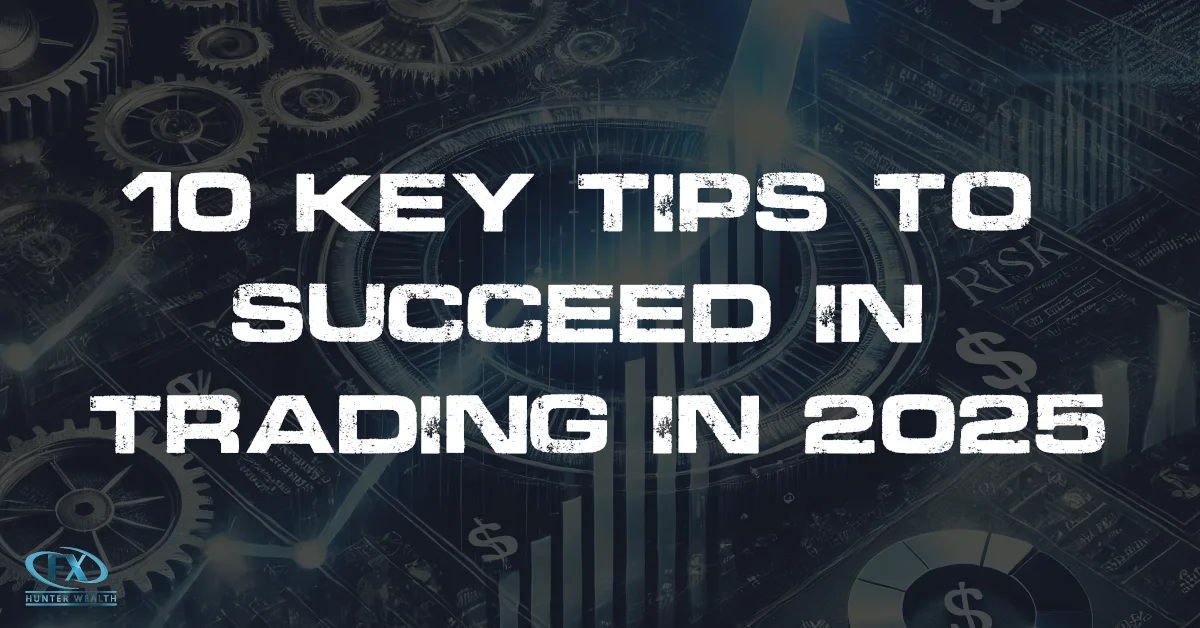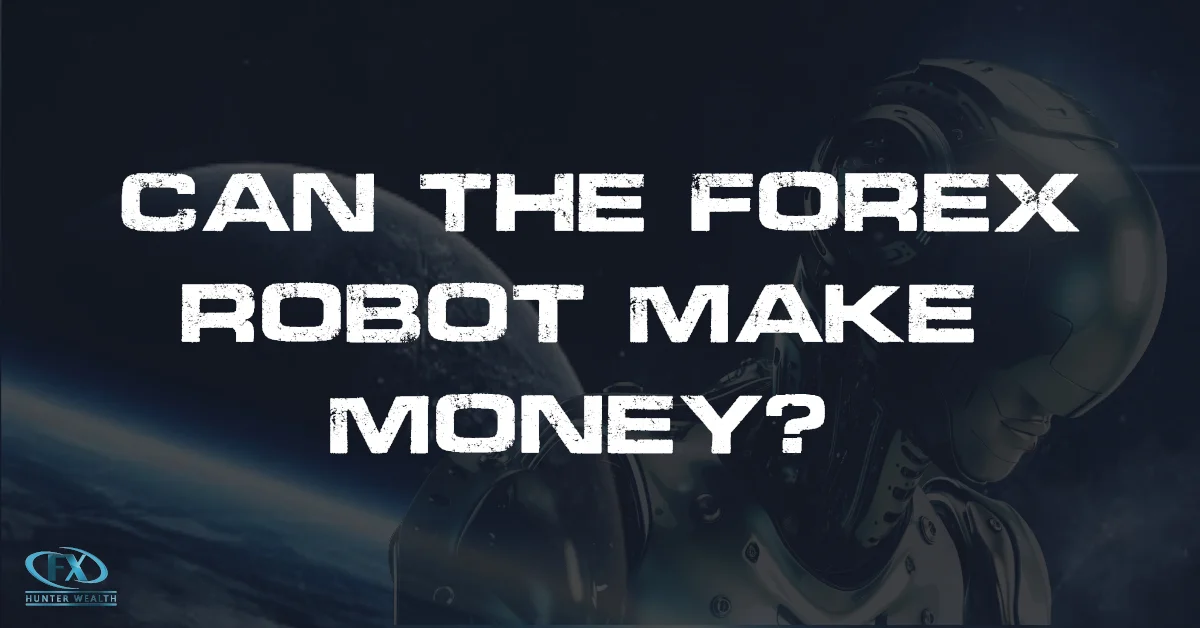Today, let’s take a look back at how everything in 2007 was sunny until it wasn’t. And we will compare it with today’s data.
The current market situation, through the rhetoric and actions of the Fed—general narrative, interest rates, inflation, unemployment, etc.—is very similar to the state that preceded past crises.
Yes, history is not a guarantee that the future will be the same, but it is a guide that should not be ignored. It’s good to take at least the main lessons from it because listening to the general sentiment and talking heads on TV often doesn’t pay off. Those who now lament that the Fed is unnecessarily and excessively lowering rates will be the ones shouting the loudest in six months for the Fed to continue lowering them. Ignoring the past is like voting for Kamala Harris and expecting change and development. Sorry, white braindead dudes…
So, let’s get to the main message of today’s article: We will take a very detailed look at 2007 and how it all unfolded step by step. First, we’ll analyze 2007, and then compare it with 2024. After that, we’ll look at the financial “health” of the average US consumer and American companies.
Let’s go!!
CHAPTER 1: THE YEAR 2007
The first rate cut was at the September FOMC meeting on 18.9.2007 by 50bps to 4.75%. The market was shocked by this Fed decision because it expected a cut of only 25bps, and articles began appearing everywhere that the Fed was ahead of itself and would cause inflation and another endless stock market rise. The Fed succumbed to market pressure! Below is an excerpt from The NY Times article:



The next rate cut came at the November meeting by 25 basis points (bps) and another 25 bps at the December meeting. “Let’s enjoy Christmas in peace, there’s nothing to worry about, we’re lowering rates for a soft landing. Like lying down in a bed with Egyptian cotton sheets.”
But then the new year arrives, and it seems Wall Street spent all its money on gifts because a week before the planned January FOMC meeting, an EMERGENCY MEETING is held, and the Fed cuts rates by 75 bps. A week later, at the planned FOMC meeting on January 30, 2008, another 50 bps cut brings rates down to 3%. In March, another 75 bps cut follows, and in April, another 25 bps, bringing the total to 2%.
Then comes a long pause until early October, when the Fed holds another EMERGENCY MEETING and cuts rates by 50 bps. Immediately at the next planned FOMC meeting two weeks later, it cuts again by 50 bps to a final 1% interest rate.
Here it is an Excel chart for better clarity !!

Here is a complete overview of the rate cuts during this period:

Let’s forget about the Fed Funds for a moment and look at what the yield curve (US02Y YIELD) on 2-year bonds was doing.
Since the first rate cut in September 2007, it went down and then dropped another 82% over the next 12 months!

What were MONEY SUPPLY and INFLATION doing during this period?
Both money supply and inflation were rising. M2SL increased from $7.4 trillion to $8.2 trillion, and inflation rose from about 2.8% to 5.4%. However, this range in inflation was completely normal since 1982, as we had been moving within this range. Although inflation had a momentary rise, it was nothing out of the ordinary and then experienced an absolute washout.

It’s crucial to keep asking the key question: What was the narrative at that time? What was the “general” opinion and sentiment? It was: The Fed gave in, the bull run continues, inflation is up, the market is saved, and the Fed is overdoing it, buddy, unnecessarily.
What about the long pause between April and October when rates were flat?
It was half a year of stabilization, waiting to see what would happen. They were worried that they had cut rates so aggressively that they were ahead of the market and now had to wait for the market to calm down. Read: every pundit in the news claimed the Fed had overdone it and was unnecessarily aggressive.
So, when did the total meltdown in the stock market begin?
During the pause in interest rates between April and October 2008, the market was relatively stable and only lost about 15% of its value. It was only after this period that the real crisis hit, and the DJI lost another 41% of its value over the next six months – SEE GRAPH BELOW.

Let’s put everything together for the year 2007:
Comparison of US02Y Yield, DJI, Unemployment, and Interest Rates:

- US02Y Yield: The yield on 2-year bonds dropped significantly, falling by 82% over the next 12 months after the first rate cut in September 2007.
- DJI (Dow Jones Industrial Average): The market initially surged to new all-time highs but later experienced a significant downturn.
- Unemployment: Remained relatively stable around 4.7% during this period.
- Interest Rates: The Fed cut rates multiple times, starting with a 50 bps cut in September 2007, followed by several more cuts, eventually bringing the rate down to 1% by the end of the period.
Alright, let’s take a look at what GOLD and the VIX were doing at that time. Gold kept hitting new all-time highs, while the VIX was lying in bed with a cold until October 2008. In short, it took about 13 months from the first rate cut for the VIX to show any significant upward movement, which then triggered the final cascade of the entire market.
From the first rate cut in September 2007 to March 2008, gold increased by 38%, while the VIX remained dormant. The VIX only started to spike in October 2008 after the Fed had kept rates flat for six months, leading to the real and juicy market meltdown.

Alright, enough history, let’s move on to the current state.
Chapter 2: The Year 2024
Now, let’s shift to the present and look at what the same charts, narratives, and everything else tell us today. We’ll start with the Fed. We’ll always start with the Fed because it’s our bestseller.
Surprise, surprise, the Fed cut rates on September 18, 2024, exactly like in 2007, by 50 basis points to 4.75%1. The talking heads are just as shocked and fascinated by this event as they were in 2007.

For the upcoming meetings, the expectation is a 25 bps cut in November and another 25 bps cut in December. Any resemblance to 2007 is purely coincidental…
What about the indexes?
Well, we’re hitting new endless records, champagne is flowing, and we’re using rolled-up newspapers for coke because banknotes are too small. In LalaLand, the DJI reaches 43,100 USD and the S&P500 hits 5,900 USD. The crowds are going wild…

The current sentiment, according to “experts,” is:

According to a survey, only 8% of respondents expect something like a hard landing. Yuck, who would want a hard landing? 76% expect a soft landing, and the rest prefer not to expect anything at all.
Notice how the probability of a HARD LANDING has been decreasing throughout the year. This reflects the general sentiment because if a crisis were to happen, it would have come long ago.
What about UNEMPLOYMENT?
It remains stable at around 4.1%, but due to statistical errors from the statistical office, we will have to wait about 12 months for the actual values.
What about the MONEY SUPPLY and INFLATION charts?
The money supply is increasing, and inflation is back in its “comfort zone” of around 2-5%.

Let’s put everything together for the year 2024:
Comparison of US02Y Yield, DJI, Unemployment, and Interest Rates:

Let’s put everything together for the year 2024:
Comparison of US02Y Yield, DJI, Unemployment, and Interest Rates:
- Interest Rates: Decreased from 4.75% to 4.25% (a reduction of 50 basis points).
- Unemployment: Increased from approximately 3.4% to 4.4%.
- US02Y Yield: Dropped from 5.2% to 3.5%.
- Dow Jones Index: Continues to hit new all-time highs every day.
And what about the GOLD and VIX charts?
Gold has risen by about 9% since the first rate cut, reaching new all-time highs (ATHs), while the VIX is still “sleeping” and pretending not to notice.
That’s all well and good, but what does it all mean?!
YEAR 2007 vs 2024
It means that if we look closely and with the benefit of hindsight at 2007, the current situation is not just similar to before, it is EXACTLY the same. I don’t believe that history will repeat itself step by step and down to the last detail as before, but this comparison is meant to show you that most events can be seen in the data in advance. However, it’s hard to find this information through the disinformation deluge we call MAINSTREAM MEDIA.
Macro charts, which most smart money follows and which have historically proven to be very accurate, show the same sequence of events as in 2007-2008. Additionally, China is already experiencing a similar real estate crisis as in 2008 (their words, not mine) and they think they can cover a 20 trillion loss with a 500 billion package. That will require a lot of prayers and incense sticks…
CHAPTER 3: STRONG ECONOMY AND INDOMITABLE CONSUMER
Powel, Yellen and all politics still speaking about a strong economy, I don’t know if they are intentionally lying or they are stupid. but here is retail data? How is the average American citizen doing, who barely finished high school, sleeps with a machine gun under their pillow, doesn’t have a passport, and thinks Africa is just below England?
Average Americans are starting to drown in debt, and the chance of defaulting on the minimum debt in the next 3 months is increasing to about 14%.

Auto loan defaults 90 days past due are now at 2.9%. Highest in 14 years.

let’s look at ALL loan defaults together:

We are in a very, very similar situation to 2007. There is no extreme yet, but notice how everything is starting to prepare for expansion. I don’t give it much weight as long as we’re below about 2, but I definitely wouldn’t support this chart because it’s another piece of our MACRO puzzle.
What about the labour market?
The labour market in the USA has fallen to 34.2 hours in terms of average hours worked per week. This is the lowest in 14 years. It is a continuous decline, with the labor market weakening for 8 months in a row, starting with the slow reduction of full-time jobs to part-time jobs and continuing with the gradual reduction of the workforce.

Moreover, most large companies plan to lay off more employees at the beginning of the new year, which will result in hundreds of thousands of people losing their jobs. Last month, the number of part-time jobs was at 28.16 million. The third highest number in history and 400,000 more than in 2008.
Additionally, household investment in the stock market is at an absolute maximum, with the average Joe having over 48% of their assets in stocks. Double the value of the last 15 years.

Well, everyone has some stocks, what’s wrong with that?
There’s nothing wrong with investing in stocks, quite the opposite. Anyone with a bit of extra money should have a portion of their assets in quality stocks. However, it’s always important to keep in mind what the smart money is doing.

The problems that crush the middle class are of course also connected to the real estate market.US housing affordability is currently the worst since 1985 and we are below 2008 levels!That’s not even talking about how many properties are now for sale in the US below pre-Covid values.

What about companies? How do entrepreneurs succeed and why does it all take so long?
First, we have the US election in about 3 weeks, and Japan’s Powell (samurai sake kimono, or something) has confirmed that the BOJ will not raise rates until after the US election.
Moreover, the buy back in stocks has never been as brutal as this year 2024 – see chart below.

Come on, it’s cool, isn’t it? When a snake starts eating itself, maybe it’s a long enough snake. The problem is that the SPX index consists of 7 strong companies. The remaining 493 companies report yet another quarter when they have a 0% increase in earnings.493 companies do not even meet the reduced expectations for 2024.

But Magnificent 7 and AI Narrative will take it all by themselves. We’re already looking forward to having a robot make us a drink and getting into Elon’s autonomous taxi… which will actually be driven by a remote-controlled Indian from somewhere in the basement of Marrakesh.
The Russell index is not much better, with so-called “zombie companies” reporting negative earnings reaching over 43% of the index.

Buffet is not buying properly for the past 3 years and he is sitting on the historically biggest cash positions. He is waiting for the opportunity, which can come soon or next year. This is macro and it has a much longer timing.
This week NFP is expected to drop Significantly. Growing unemployment + fed rapid rate cuts are the last pieces to the puzzle. Now you might ask yourself what to do.
Definitely don’t be leveraged in any position. Be solvent and make sure you have a stable income. Have cash to use it on this lifetime buy opportunity and buy some great assets when the interest rate hits 0% it could be the bottom of the crash. Will Bitcoin protect you? I don’t know, Bitcoin was not thru such a crisis yet.
Ofcourse as usually this is not financial advice just my opinion. Do your own research.
Stay strong
Dave FX Hunter







